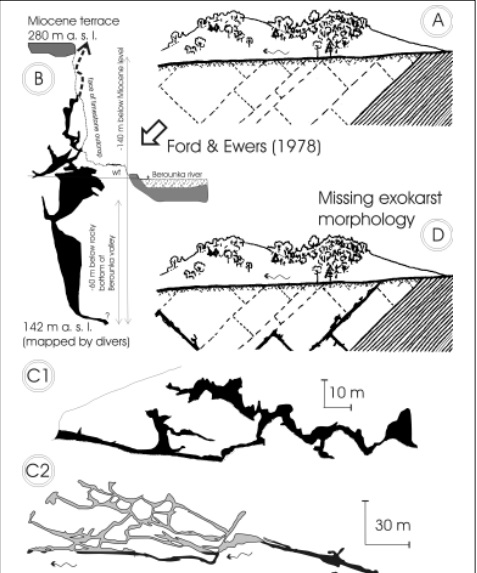Factors Controlling Exokarst Morphology and Sediment Transport Through Caves: Comparison of Carbonate and Salt Karst
DOI:
https://doi.org/10.3986/ac.v32i1.366Abstract
Zaradi velike topnosti NaCl se v solnem krasu lahko za stalno odlagajo v podzemlju velike količine sedimentov. Tam so posebne kraške oblike, kakršnih ni v karbonatnem krasu: veliki podzemeljski vršaji, notranje jame. Nasprotno pa se v karbonatnem krasu le majhen del sedimentov, ki jih prenaša alohtoni tok, za stalno odloži v jami, saj bi bila sicer jama kmalu zamašena (zaradi zelo slabe topnosti CaCO3 ). Na ozemlju Češke republike so bila z različnih vidikov preučevana tri kraška ozemlja z zelo dolgim razvojem in bistvenimi razlikami med površinskimi in podzemeljskimi oblikami. Avtorja menita, da je le ena bistvena razlika med Moravskim krasom in kraškimi ozemlji z razpršenim napajanjem (Češki in Chýnovski kras): v gostoti in smeri razpok, po katerih prenika kraška voda. Vse ostale razlike v površinskih in podzemeljskih kraških oblikah so nastale zaradi prvotnih razlik in njihovega vpliva na razvoj jam, posebej na prenos sedimentov in na stopnjaste oblike. Na ozemlju, kjer so le batifreatične in globokofreatične jame, se nikoli ne razvijejo slepe doline in druge navadne površinske kraške oblike zaradi zelo počasnega toka v kraških prevodnikih, kar onemogoča prenašanje sedimentov.
In salt karst, very large amounts of sediment load could be permanently trapped underground, due to the high solubility of NaCl. Specific karst forms which have no equivalents in carbonate karst, occur there (huge underground alluvial fans, inlet caves). In a carbonate karst, on the other hand, only small portion of sediment carried by an allochthonous stream could be deposited permanently in the cave, otherwise the cave will become clogged (because of the very low solubility of CaCO3). Three carbonate karst areas with long-lasting development and fundamental differences in endokarst and exokarst forms were studied from many different aspects in the Czech Republic. The authors believe that there is only one primary difference between the Moravian Karst and diffuse recharge karst areas (Czech and Chùnov karsts): the frequency and orientation of fissures penetrable by groundwater. All other differences in exokarst and endokarst forms and hydrology are the results of primary difference and its influence on speleogenesis, especially on sediment transport and gradational features. In areas where only bathyphreatic and deep phreatic caves occur, blind valleys and common exokarst morphology never develop, due to the very low velocity of flow in karst conduits, which precludes transport of sediment load.
Downloads

Downloads
Published
How to Cite
Issue
Section
License
Authors guarantee that the work is their own original creation and does not infringe any statutory or common-law copyright or any proprietary right of any third party. In case of claims by third parties, authors commit their self to defend the interests of the publisher, and shall cover any potential costs.
More in: Submission chapter




